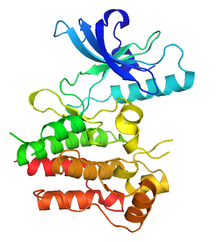- MuSK protein
-
muscle, skeletal, receptor tyrosine kinase Identifiers Symbol MUSK Entrez 4593 HUGO 7525 OMIM 601296 RefSeq NM_005592 UniProt O15146 Other data Locus Chr. 9 q31.3-q32 MuSK (for Muscle Specific Kinase) is a receptor tyrosine kinase required for the formation of the neuromuscular junction. It is activated by a nerve-derived proteoglycan called agrin.
Contents
MuSK is required for formation of the Neuromuscular Junction
During development, the growing end of motor neuron axons secrete a protein called agrin.[1] This protein binds to several receptors on the surface of skeletal muscle. The receptor that seems to be required for formation of the neuromuscular junction (NMJ), which comprises the nerve-muscle synapse, is called MuSK (Muscle-specific kinase).[2] MuSK is a receptor tyrosine kinase - meaning that it induces cellular signaling by causing the addition of phosphate molecules to particular tyrosines on itself, and on proteins that bind the cytoplasmic domain of the receptor.
The requirement for MuSK in the formation of the NMJ was primarily demonstrated by mouse ("knockout") studies. In mice that are deficient for either agrin or MuSK, the neuromuscular junction does not form. Many other proteins also comprise the NMJ, and are required to maintain its integrity. For example, MuSK also binds a protein called "downstream-of-tyrosine-kinase-7" (Dok-7). Dok-7's PTB domain binds phosphorylated MuSK, which acts to stabilize active MuSK or alternatively enhance MuSK's own kinase activity.
MuSK signaling
Upon activation by its ligand agrin, MuSK signals via the proteins called Casein kinase 2 (CK2),[3] Dok-7[4] and rapsyn, to induce "clustering" of acetylcholine receptors (AChR). Both CK2 and Dok-7 are required for MuSK induced formation of the neuromuscular junction, since mice lacking Dok-7 failed to form AChR clusters or neuromuscular synapses, and since downregulation of CK2 also impedes recruitment of AChR to the primary MuSK scaffold. In addition to the proteins mentioned, other proteins are then gathered, to form the endplate to the neuromuscular junction. The nerve terminates onto the endplate, forming the neuromuscular junction - a structure required to transmit nerve impulses to the muscle, and thus initiating muscle contraction.
MuSK's role in disease
Antibodies directed against this protein are found in those patients with myasthenia gravis not demonstrating antibodies to the acetylcholine receptor (sero-negative).[5] The phenotype of these patients appears to be different from many other myasthenic patients; more likely women, less eye involvement, more likely to have weakness of neck and oropharynx and more likely to be African-American in ethnicity.
References
- ^ Glass D et al. (1996). "Agrin acts via a MuSK receptor complex". Cell 85 (4): 513–23. doi:10.1016/S0092-8674(00)81252-0. PMID 8653787.
- ^ DeChiara T et al. (1996). "The receptor tyrosine kinase MuSK is required for neuromuscular junction formation in vivo". Cell 85 (4): 501–12. doi:10.1016/S0092-8674(00)81251-9. PMID 8653786.
- ^ Cheusova T et al. (2006). "Casein kinase 2-dependent serine phosphorylation of MuSK regulates acetylcholine receptor aggregation at the neuromuscular junction". Genes Dev 20 (13): 1800–16. doi:10.1101/gad.375206. PMC 1522076. PMID 16818610. http://www.pubmedcentral.nih.gov/articlerender.fcgi?tool=pmcentrez&artid=1522076.
- ^ Okada K et al. (2006). "The muscle protein Dok-7 is essential for neuromuscular synaptogenesis". Science 312 (5781): 1802–5. doi:10.1126/science.1127142. PMID 16794080. http://www.sciencemag.org/cgi/content/abstract/312/5781/1802.
- ^ Hoch W et al. (2001). "Auto-antibodies to the receptor tyrosine kinase MuSK in patients with myasthenia gravis without acetylcholine receptor antibodies". Nat Med 7 (3): 365–8. doi:10.1038/85520. PMID 11231638.
Protein kinases: tyrosine kinases (EC 2.7.10) Receptor tyrosine kinases (EC 2.7.10.1) Insulin receptor familyPDGF receptor familyFGF receptor familyVEGF receptors familyHGF receptor familyTrk receptor familyEPH receptor familyLTK receptor familyTIE receptor familyROR receptor familyDDR receptor familyPTK7 receptor familyRYK receptor familyMuSK receptor familyMUSKROS receptor familyAATYK receptor familyAXL receptor familyRET receptor familyuncatagorisedNon-receptor tyrosine kinases (EC 2.7.10.2) ABL familyACK familyCSK familyFAK familyFES familyFRK familyJAK familySRC-A familySRC-B familyTEC familySYK familyCategories:- Genes on chromosome 9
- Tyrosine kinase receptors
- Developmental neuroscience
- Proteins
Wikimedia Foundation. 2010.

